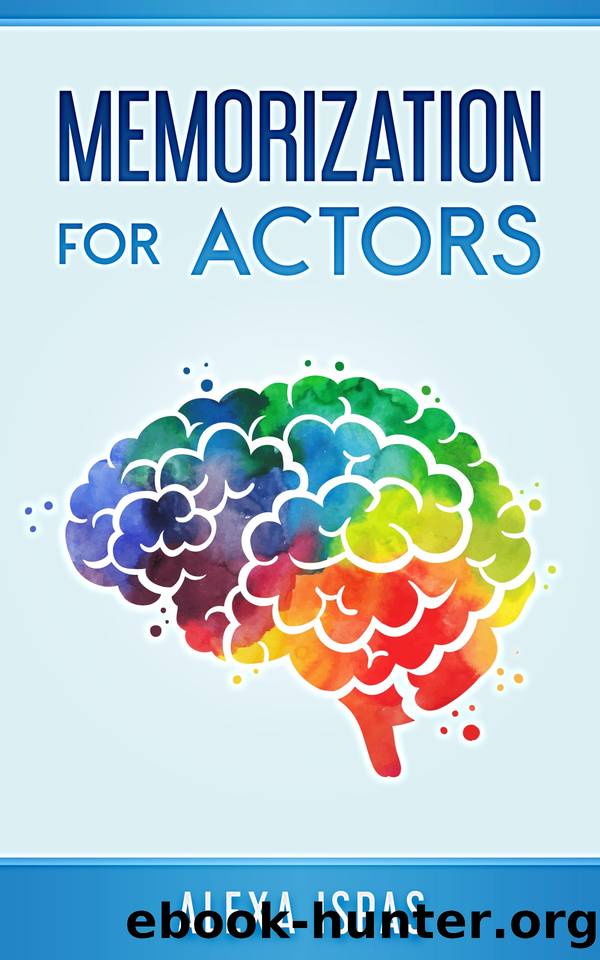Memorization for Actors by Alexa Ispas

Author:Alexa Ispas [Ispas, Alexa]
Language: eng
Format: epub
Tags: Performing Arts, Acting & Auditioning, Self-Help, Personal Growth, Memory Improvement, theater, Stagecraft & Scenography, Monologues & Scenes, dance, Classical & Ballet, music, General, Psychology, Applied Psychology
ISBN: 9781913926069
Google: -HwxEAAAQBAJ
Publisher: Word Bothy
Published: 2021-05-30T23:22:36.529952+00:00
* * *
Step 2: Choose a âretrieval cueâ for each chunk
You have so far divided up your lines into chunks that are short enough for you to start memorizing and have made some progress towards memorizing these chunks.
It is now time for the next stage of the process: gradually putting your chunks aside and trying to remember them from memory.
How can you make this stage of the process as effective as possible?
By setting up a so-called âretrieval cueâ for each of your chunks.
A retrieval cue is a memorable word that works the same way as a stage cue.
When the retrieval cue is called, the actor (i.e. the chunk) steps in.
A retrieval cue is therefore a short-hand version of the chunk to which it is attached.
What works well as a retrieval cue differs from person to person.
Perhaps a word you stumble upon regularly in a particular chunk is a perfect retrieval cue for that chunk.
Once you remember that word, the rest of the chunk comes easily.
Or perhaps you could choose the first word of that chunk as your cue.
Retrieval cues can be a huge help in speeding up your memorization process.
It is therefore worth experimenting with different cues to find out which are the most effective ones for you.
Whichever word you choose as your retrieval cue for a chunk, the main point is that it should be memorable and meaningful to you.
The more memorable the retrieval cue, the quicker you will be able to remember the chunk to which it relates.
Choose seven retrieval cues, one for each chunk.
Make a list of your retrieval cues on a separate piece of paper.
As you attempt to remember the chunks from memory, see if you can rely on your retrieval cues, instead of looking at your chunks.
Eventually you wonât need the chunks any more.
You will only need to refer to your retrieval cues.
Once you can say all the chunks with only the help of the retrieval cues, put the chunks away.
Keep your list of retrieval cues close, but not too visible.
Try saying the text without looking at your retrieval cues.
Only look at your retrieval cues when you get stuck.
Make sure that if you change the size of your chunks as you make progress with learning the lines, you remember to also change the retrieval cues relating to each chunk.
By the end, you should only have seven chunks and seven retrieval cues, no matter how long the text.
You should be able to remember your chunks easily, without needing to look at the retrieval cues.
Download
This site does not store any files on its server. We only index and link to content provided by other sites. Please contact the content providers to delete copyright contents if any and email us, we'll remove relevant links or contents immediately.
Kathy Andrews Collection by Kathy Andrews(11767)
The remains of the day by Kazuo Ishiguro(8896)
Spare by Prince Harry The Duke of Sussex(5142)
Paper Towns by Green John(5141)
The Body: A Guide for Occupants by Bill Bryson(5033)
Industrial Automation from Scratch: A hands-on guide to using sensors, actuators, PLCs, HMIs, and SCADA to automate industrial processes by Olushola Akande(5027)
Machine Learning at Scale with H2O by Gregory Keys | David Whiting(4262)
Be in a Treehouse by Pete Nelson(3999)
Never by Ken Follett(3885)
Harry Potter and the Goblet Of Fire by J.K. Rowling(3810)
Goodbye Paradise(3767)
Into Thin Air by Jon Krakauer(3350)
The Remains of the Day by Kazuo Ishiguro(3348)
Fairy Tale by Stephen King(3310)
The Cellar by Natasha Preston(3299)
The Genius of Japanese Carpentry by Azby Brown(3256)
120 Days of Sodom by Marquis de Sade(3229)
The Man Who Died Twice by Richard Osman(3042)
Drawing Shortcuts: Developing Quick Drawing Skills Using Today's Technology by Leggitt Jim(3040)
